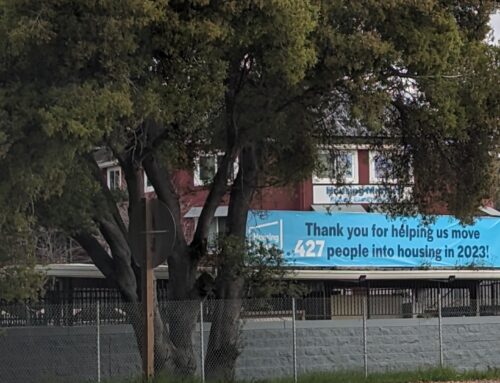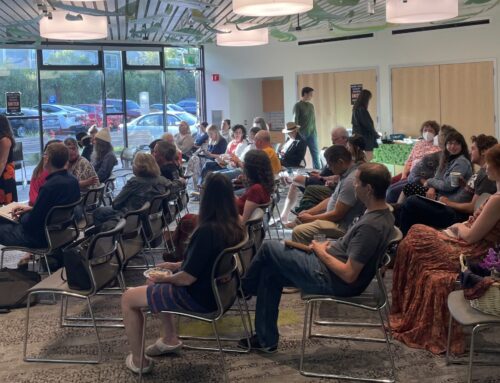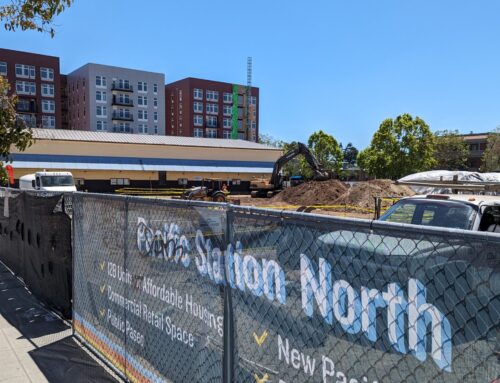
The Housing Authority of the County of Santa Cruz is at 2160 41st Ave. in Capitola. (Stephen Baxter — Santa Cruz Local file)
SANTA CRUZ >> An Emergency Housing Voucher program helped more than 400 unhoused people find permanent homes in Santa Cruz County in recent months, but the demand for rent help continues to outstrip supply.
Emergency Housing Vouchers are for people who are homeless or at risk of becoming homeless. The County of Santa Cruz’s Rehousing Wave project aimed to find permanent homes for people who were in shelters during the COVID-19 pandemic with Emergency Housing Vouchers. The program offered a $2,000 signing bonus for landlords, 24-hour emergency support and one-on-one case management between tenants and county officials if landlords needed help.
- Starting in October 2021, 425 people in 295 households found permanent homes with Emergency Housing Vouchers. That rate of voucher acceptance was the highest of any jurisdiction in California, according to the Housing Authority of the County of Santa Cruz
- About 44% of those households had children, and a similar percentage included people older than 60. About 48% were Latino, according to the housing authority.
- Homes were provided by 188 property owners and agents in the program. Incentives and relationships with landlords helped the cause, leaders said.
Separate from Emergency Housing Vouchers, Housing Choice vouchers subsidize the rent of Santa Cruz County residents. The Section 8 program was renamed Housing Choice several years ago.
There are about 5,500 vouchers available for tens of thousands more county residents who are eligible, said Jenny Panetta, executive director of the Housing Authority of the County of Santa Cruz. The waitlist has been closed since 2018. It is expected to reopen when 300 to 400 households with vouchers find rentals, Panetta said.
“We are barely scratching the surface regarding need,” Panetta said. “The need for subsidized assistance in Santa Cruz County is far greater than the amount (of vouchers) available.”
More than 10,000 households in the county are expected to wait about six years to get a Housing Choice voucher, Panetta said.
The waitlist fills up quickly in Santa Cruz County because it’s a desirable place to live, Panetta said. Based on rents, Santa Cruz County is also the second most expensive in the nation, according to a 2022 report by the National Low Income Housing Coalition. San Francisco, San Mateo and Marin counties formed the most expensive area, according to the report.
Although it has been difficult for many voucher holders to find a landlord willing to accept a voucher, some landlords have had success with the program.
Darius Mohsenin is a Santa Cruz County landlord who said he rents to voucher holders to try to help local families and businesses. He has 44 units in Santa Cruz, eight units in Watsonville and several units outside the county. He said 39 of his units are rented to voucher holders.
“Look, you’ll have good renters and bad ones regardless if they are on Section 8 or not,” Mohsenin said. “In fact, they actually make better tenants than those paying regular rent.”
A landlord’s experience
Mohsenin said, “See, most people with vouchers feel like they have hit the lottery and are so grateful to be given the gift of a clean, safe apartment near one of the best piers in California, that they respect the rules of the landlord and Section 8,” Mohsenin said. “They know that if they don’t, they’ll lose their vouchers and get kicked out onto the street.”
Mohsenin said that there is less tenant turnover with Housing Choice voucher tenants because good units are hard to find. “When they find a decent landlord with a decent unit, they’ll never leave,” He went on, “Many Section 8 tenants don’t drive, and that means fewer cars and parking issues at the units,” Mohsenin said.
Panetta, the Santa Cruz County Housing Authority leader, said there are responsible and irresponsible tenants regardless of whether they hold a voucher.
“There is just as much diversity in tenants among those with as without vouchers. And anyway, in the rare case a Section 8 tenant damages property or fails to pay rent, the Santa Cruz County Housing Authority will reimburse the property owner up to $5,000 remedial funds,” Panetta said.
With the adoption of California law SB 329 in 2019, it’s illegal for a landlord to reject a prospective tenant because they have a voucher. Still, some landlords find other reasons to reject prospective tenants with vouchers.
“Section 8 discrimination often goes unreported because many landlords and renters are still unaware it’s illegal,” Panetta said renters often want to report discrimination violations but don’t know how.
Panetta expressed hope that renters would report discrimination, but filing a formal complaint against a discriminatory landlord with the Department of Fair Employment and Housing takes time.
How housing vouchers work
Tenants with Housing Choice vouchers pay about 30% of their income toward the rent, and the housing authority pays the remainder of the rent directly to the landlord. A typical Housing Choice voucher provides about $1,800 per month, Panetta said. The voucher amount varies based on the renter’s income, family size and rental.
Once a voucher is received, the holder has six months to find a place. The voucher holder can apply to extend the expiration date in three-month increments until a home is secured.
Landlords who want to rent to voucher holders should contact the Santa Cruz County Housing Authority, fill out some tax and application forms, then schedule an appointment to have the rental inspected (to be sure it’s up to code). Once the unit passes muster, all sign off on the final paperwork and the voucher holder now has a place to call home.
Some landlords shy away from the program because they fear their unit will not meet Section 8 criteria. The housing authority offers incentives for repairs. If the rental unit does not pass inspection, there is money available for the landlord to make the required improvements.
Panetta said housing vouchers have a positive “ripple effect”on the families and the community.
For property owners in Live Oak and other unincorporated Santa Cruz County areas, people who build in-law units and rent them to low-income residents at more affordable rents can receive forgivable loans of up to $40,000.
Although the wait for Housing Choice vouchers is long, some other waitlists and programs can help residents find affordable housing.
- The Housing Authority website lists about 100 apartment complexes with separate housing subsidy programs, although vacancies vary.
- The Resetar Residential Hotel has a waitlist for 52 units at 15 W. Lake Ave., Watsonville.
- El Centro Residential Apartments has a waitlist for 45 units at 1110 Pacific Ave., Santa Cruz. Applicants must be 60 or older.
- Sunrise Senior Apartments at 580 Westside Blvd., Hollister has a waitlist for low-income heads of households who are 62 and older.
- The Housing Authority sends “affordable housing alerts” to housing seekers who sign up on the authority’s website.
- Other housing assistance programs are on the Housing Authority website.
- Learn more on Santa Cruz Local’s resource page “How to get Rent Assistance in Santa Cruz County.”
Tips for housing seekers
Sylvia Soto is a local housing navigator. Part of Soto’s job is to help residents find stable and secure housing. She had tips regarding how voucher holders can increase their odds of finding a landlord willing to rent to them.
- Secure references: Past rental references play a big part in securing housing, but it is often difficult for people coming out of homelessness, Soto said. “Anything is better than nothing regarding references, so at the very least, she suggested keeping a record of any past residences,” even if it was at a shelter or a friend’s house.
- Give the landlord a tenant résumé. One landlord said he appreciates when tenants provide a tenant résumé that describes what they bring to the table as a renter and as a person. “A document like this shows me the tenant is really motivated and on top of things,” Moshenin said.
- Try to raise your credit score: Soto said it’s not essential to have a “good” credit score, but “a low score removes about 50% of the rental possibilities.” There are several strategies to improve a credit score. Having a simple checking account also helps. “Occasionally property management companies will ask for bank statements in addition to applications, and it helps so they can have an easy way to make rent deposits into a landlord or property management bank account,” Soto said.
- Don’t mention the voucher immediately: “Don’t mention the voucher right away. Let the landlord see and get to know you a bit first,” Soto said. “Mention it after you’ve applied and met the landlord in person.”
- Words matter: Years ago, Section 8 vouchers were renamed Housing Choice vouchers. A way to bring up the topic might start with, “Would you be open to taking a government Housing Choice Voucher? I’m participating in a Santa Cruz County program that gives rental assistance to people who make less than $55,000 per year, and since I currently fall into that category….” Then go on to explain how the voucher works, because many landlords don’t know.
Questions or comments? Email [email protected]. Santa Cruz Local is supported by members, major donors, sponsors and grants for the general support of our newsroom. Our news judgments are made independently and not on the basis of donor support. Learn more about Santa Cruz Local and how we are funded.

Karyn Cortani
Karyn Cortani is a non-fiction freelance writer in Santa Cruz County. Cortani has written for Forza, European Car and Inventors Digest.




